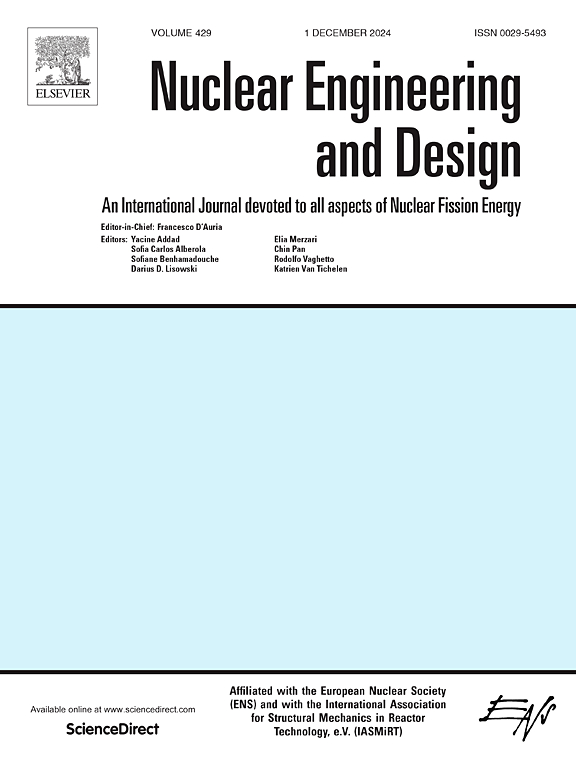半分辨和分辨LSMPS-DEM对二维固体颗粒沉降行为的综合研究
IF 2.1
3区 工程技术
Q1 NUCLEAR SCIENCE & TECHNOLOGY
引用次数: 0
摘要
在钠冷却快堆发生严重事故的后期,熔化的燃料落入液态钠冷却剂中,形成一个碎片床。碎屑床的冷却性直接影响熔池是否再热,从而威胁到压力容器下封头的完整性,对安全至关重要。碎屑床的冷却性与其形状和大小密切相关,而形状和大小又取决于碎屑床的形成行为。因此,准确模拟碎屑床的形成过程具有十分重要的意义。由于其拉格朗日特性,颗粒法在模拟颗粒碎片在液体中的沉降和堆积过程中具有显著的优势。现有的研究主要集中在已分辨模型的应用上,而半分辨模型的研究主要局限于基于网格的方法,其在粒子方法中的适用性尚未得到系统的探讨。为了弥补这一研究空白,本研究深入分析了粒子法中已分辨和半分辨模型的适用范围。结果表明:在颗粒法中,当流体颗粒间距与固体颗粒直径之比小于等于0.5时,应采用分解模型;当比值为1或2时,半分辨模型更为合适。研究结果表明,采用大颗粒的分解模型和中小颗粒的半分解模型可以更详细、准确地模拟碎屑床的形成行为,为进一步研究混合粒径条件提供了基础。本文章由计算机程序翻译,如有差异,请以英文原文为准。
Comprehensive investigation of the semi-resolved and resolved LSMPS-DEM for two-dimensional solid particle settling behavior
In the late stages of severe accidents in sodium-cooled fast reactors, molten fuel falls into the liquid sodium coolant, forming a debris bed. The coolability of this debris bed directly influences whether the molten pool will undergo reheat, thereby threatening the integrity of the pressure vessel lower head, which is critical for safety. The coolability of the debris bed is closely related to its shape and size, which in turn depend on its formation behavior. Therefore, accurately simulating the formation process of the debris bed is of great importance. Due to its Lagrangian characteristics, the particle method demonstrates significant advantages in simulating the settling and accumulation processes of particle fragments in liquids. Existing studies have predominantly focused on the application of resolved models, while research on semi-resolved models remains largely confined to grid-based methods, and their applicability in the particle method has yet to be systematically explored. To address this research gap, this study conducts an in-depth analysis of the applicable ranges of resolved and semi-resolved models within the particle method. The results show that in the particle method, when the ratio of fluid particle spacing to solid particle diameter is less than or equal to 0.5, the resolved model should be used; when the ratio is equal to 1 or 2, the semi-resolved model is more suitable. These findings suggest that using the resolved model for large particles and the semi-resolved model for small-to-medium particles could enable more detailed and accurate simulations of debris bed formation behavior, providing a foundation for future investigations into mixed particle size conditions.
求助全文
通过发布文献求助,成功后即可免费获取论文全文。
去求助
来源期刊

Nuclear Engineering and Design
工程技术-核科学技术
CiteScore
3.40
自引率
11.80%
发文量
377
审稿时长
5 months
期刊介绍:
Nuclear Engineering and Design covers the wide range of disciplines involved in the engineering, design, safety and construction of nuclear fission reactors. The Editors welcome papers both on applied and innovative aspects and developments in nuclear science and technology.
Fundamentals of Reactor Design include:
• Thermal-Hydraulics and Core Physics
• Safety Analysis, Risk Assessment (PSA)
• Structural and Mechanical Engineering
• Materials Science
• Fuel Behavior and Design
• Structural Plant Design
• Engineering of Reactor Components
• Experiments
Aspects beyond fundamentals of Reactor Design covered:
• Accident Mitigation Measures
• Reactor Control Systems
• Licensing Issues
• Safeguard Engineering
• Economy of Plants
• Reprocessing / Waste Disposal
• Applications of Nuclear Energy
• Maintenance
• Decommissioning
Papers on new reactor ideas and developments (Generation IV reactors) such as inherently safe modular HTRs, High Performance LWRs/HWRs and LMFBs/GFR will be considered; Actinide Burners, Accelerator Driven Systems, Energy Amplifiers and other special designs of power and research reactors and their applications are also encouraged.
 求助内容:
求助内容: 应助结果提醒方式:
应助结果提醒方式:


